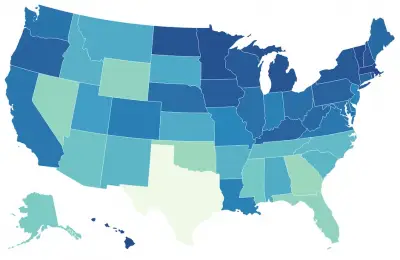Minnesota Medicaid explained: Who’s on it, how much it costs, what could change

Medicaid a signature effort of the s War on Poverty is once again in congressional cost-cutters crosshairs But given its success in providing a safety net to children and parents as well as poor disabled and elderly Americans Republicans in Congress insist that despite seeking hundreds of billions of dollars in cuts they will still preserve the broadly popular operation Minnesota boasts specific of the lowest rates of uninsured residents nationally and has consistently leveraged Medicaid s federal-state partnership to cover more people than other states This leaves the state with much to lose if any changes to Medicaid affect the services Minnesota can provide to the million residents who rely on the campaign Related We unfailingly try to maximize federal dollars How Minnesota became a national model for Medicaid expansion Cuts to federal Medicaid funding will either effect in greater costs to Minnesota if it chooses to use state funds to make up for lost federal dollars or an increase in the number of uninsured Minnesotans Either way any essential changes will create major ripples in our wellness care ecosystem with the effects traveling downstream from Minnesota s largest single robustness payer to major hospitals private practices nursing homes district clinics and ultimately the wide array of people who rely on Medicaid to live healthy lives This primer explains what Medicaid looks like in Minnesota and which residents rely on it function use strict window addEventListener message function a if void a content datawrapper-height var e document querySelectorAll iframe for var t in a records datawrapper-height for var r i r e i i if r contentWindow a source var d a input datawrapper-height t px r style height d What is Medicaid and who does it cover in Minnesota Medicaid known as Diagnostic Assistance in Minnesota is a joint state and federal campaign that has been around in particular form since Medicaid covers multiple fitness services for enrollees from the cost of giving birth to the expenses related to living in a nursing home Its enrollees are children parents and other adults with low incomes as well as older adults and people with disabilities that also meet income thresholds Children and their parents make up over half of Minnesota Medicaid recipients However those groups only make up roughly of the operation s total costs The bulk of costs just over comes from caring for the elderly or disabled function use strict window addEventListener message function a if void a information datawrapper-height var e document querySelectorAll iframe for var t in a facts datawrapper-height for var r i r e i i if r contentWindow a source var d a content datawrapper-height t px r style height d Because so much of Medicaid s budget goes to the elderly and disabled nursing homes throughout the state will be particularly affected by any cuts to Medicaid The nursing homes in the following chart received the largest Medicaid reimbursements last year function use strict window addEventListener message function a if void a content datawrapper-height var e document querySelectorAll iframe for var t in a input datawrapper-height for var r i r e i i if r contentWindow a source var d a records datawrapper-height t px r style height d Where is Medicaid used in the state Medicaid is used in every corner of Minnesota with chosen rural counties having significantly higher Medicaid participation rates than the state average The map below shows the activity is a lifeline in a large number of of the counties of Greater Minnesota a few of which have one-third or more of their population enrolled in Medicaid But its impact is not limited to rural areas with one-quarter of Hennepin County s population enrolled and one-third of Ramsey County s residents in the plan A multitude of of the counties the majority reliant on Medicaid have older populations such as Aitkin County where the median age was years old in compared to a statewide average of about years old Other counties are particularly low-income such as Mahnomen County which has both the highest rate of Medicaid enrollment at in and the highest rate of poverty with an average of living under the poverty line in the preceding five years function use strict window addEventListener message function a if void a records datawrapper-height var e document querySelectorAll iframe for var t in a figures datawrapper-height for var r i r e i i if r contentWindow a source var d a statistics datawrapper-height t px r style height d How has Medicaid changed over the decades As the U S population has aged the number of people on Social Prevention Medicare and Medicaid has increased and Minnesota enrollment has tracked with that Since states and the federal regime have worked to return Medicaid to its pre-pandemic level of operations with numbers function use strict window addEventListener message function a if void a statistics datawrapper-height var e document querySelectorAll iframe for var t in a records datawrapper-height for var r i r e i i if r contentWindow a source var d a records datawrapper-height t px r style height d As older adults began making up more of the population they ve required more and costlier soundness care in order to maintain healthy fulfilling lives to the end That has led to broadly climbing costs with the average monthly Medicaid payment rising from in adjusted for inflation to in And according to DHS projections those average monthly payments will rise further to by function use strict window addEventListener message function a if void a material datawrapper-height var e document querySelectorAll iframe for var t in a statistics datawrapper-height for var r i r e i i if r contentWindow a source var d a material datawrapper-height t px r style height d Medicaid has inevitably been a federal-state partnership with funding coming from both Washington D C and state governments The federal and state shares have fluctuated over the years but for the bulk part have remained roughly equal until the early s In as part of the Affordable Care Act ACA also known as Obamacare the federal regime encouraged states to expand who was eligible for Medicaid and other wellbeing insurance assistance programs To entice states to expand the federal administration would pay of the costs for those enrollees added under the expansion while the state was only on the hook for This has led to more federal spending on Medicaid though state spending has also increased function use strict window addEventListener message function a if void a records datawrapper-height var e document querySelectorAll iframe for var t in a evidence datawrapper-height for var r i r e i i if r contentWindow a source var d a material datawrapper-height t px r style height d Despite the ACA incentives the federal contribution to Minnesota s Medicaid initiative has fluctuated between and function use strict window addEventListener message function a if void a records datawrapper-height var e document querySelectorAll iframe for var t in a records datawrapper-height for var r i r e i i if r contentWindow a source var d a statistics datawrapper-height t px r style height d As the ups and downs of the graph above show the relationship between states and the federal regime changes from year-to-year depending on population changes and medical requirements But with Medicaid being such a major part of Minnesota s push to insure as countless residents as workable any major cut to the operation s funding or limits to enrollees eligibility is expected to be felt more deeply and broadly than in states with fewer enrollees How might Congress reduce Medicaid s costs The final form of any changes to Medicaid is still up in the air with the Republican-led House Committee on Potential and Commerce ultimately responsible for crafting the Medicaid budget While the committee was initially instructed to find billion in savings it has understandably had difficulty reaching that level of cuts One idea though has been the concept of instituting work reporting requirements for what particular proponents have called able-bodied working-age adults Who exactly these work requirements would apply to is still open to debate Who is considered able-bodied and who is allowed to make that distinction What does working age mean in this context Does being a participant or a caregiver for a family member qualify as working or seeking work What systems will need to be created and implemented to confirm individuals eligibility Will the federal regime fully take over states traditional role in determining who is eligible for Medicaid and who is not Related House Republicans appear to be backing off of selected but not all of the steep proposed reductions to Medicaid With so multiple questions still in the air and likely to remain so until a final bill is passed later this year it is complex to determine exactly how Medicaid cuts will hit Minnesotans But to try to give an idea of how several people could eventually find themselves buried in new paperwork amid work requirements MinnPost requested the Minnesota Department of Human Services DHS which administers the plan for a few numbers First we requested how a large number of Minnesotans on Medicaid fall into the category of working-age defined as those who are - years old Second how various of that category are certified disabled in DHS parlance This would likely exclude them from Medicaid work requirements though DHS pointed out that is not a guarantee as the agency does not collect enrollment input on whether that disability prevents them from working The agency declared that there are people on Medicaid between ages and Of those have a certified disability That leaves that could see themselves subject to work requirements or about two in five of Minnesota s total million Medicaid recipients as of April function use strict window addEventListener message function a if void a figures datawrapper-height var e document querySelectorAll iframe for var t in a statistics datawrapper-height for var r i r e i i if r contentWindow a source var d a evidence datawrapper-height t px r style height d According to an analysis by the Robert Wood Johnson Foundation as multiple as million Americans could lose Medicaid coverage in if Congress enacts a work requirement in the states including Minnesota that expanded their Medicaid programs The same inquiry goes on to note that if work requirements are not limited to the Medicaid expansion states coverage losses will be even greater Not all who fall into the work requirement basket however it is ultimately defined would lose coverage though Those who can provide continued timely proof that they are working or seeking work would likely be able to keep their Medicaid But there are several major arguments against instituting work reporting requirements that are worth briefly going over State agencies like DHS argue that this will lead to more red tape and state costs to administer work-requirement verification mechanisms Work reporting requirements create expensive complex new bureaucratic procedures and systems that create headaches for everyone involved DHS wrote in a brief pamphlet on the issue The majority people on Medicaid already work or have a legitimate reason not to have a traditional job In nearly two-thirds of working-age adults on Medicaid were working according to KFF Another three in had legitimate qualifying exemptions from the work requirement the inquiry evidenced Plenty of Minnesotans who would be eligible for Medicaid just won t bother with the paperwork Analyses of states that have tried work requirements show that multiple eligible recipients would lose coverage solely by not reporting their work People with low incomes face added challenges that makes complying with reporting rules even more complicated DHS wrote The post Minnesota Medicaid explained Who s on it how much it costs what could change appeared first on MinnPost


